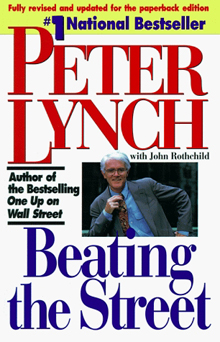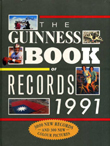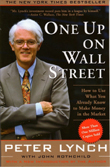February 21, 2012
Book Review: Beating the Street.
 I'm trilled to have rediscovered this book which has been sitting on my shelves for ten to fifteen years. I often recommend Peter Lynch's original book, One Up on Wall Street, but I had a confusion between Beating the Street and another, less relevant book which made me think it was not worth much. My mistake was corrected this long Carnival weekend.
I'm trilled to have rediscovered this book which has been sitting on my shelves for ten to fifteen years. I often recommend Peter Lynch's original book, One Up on Wall Street, but I had a confusion between Beating the Street and another, less relevant book which made me think it was not worth much. My mistake was corrected this long Carnival weekend. The book is conceptually divided into three parts. The first three chapters offer commentary on investing touting the superiority of stocks over bonds in the long run, the various advantages amateur investors have over professionals, and an introduction to funds. The next three chapters cover the thirteen years during which Peter Lynch was at the helm of the Magellan Fund, the years that made him a living legend. Chapters seven through twenty document how Peter Lynch picked 21 stocks for his 1992 Barron's stock picking panel presentation.
While the first two parts are easy and interesting reading, there is not much new there for the veteran investor. The stock picking exercise is the really interesting part of the book. It reminded me of the Harvard Business School case studies, in miniature, of course.
Case Studies in Miniature
Some of the book reviews at Amazon.com complain that Lynch does not offer a "formulaic" solution to investing. No such formula exists or can exist as has been shown by complex systems researcher Stuart Kauffman. If there were such a formula there would be no profit to be had in the market. But there is a method. The variation on the method by segment of the economy is exactly what Peter Lynch covers in chapters seven through twenty. This is the most practical help an individual investor can get from Peter Lynch next to having Lynch manage his money. These chapters are as follows:7.- Art, Science and Legwork (introduction to the case studies)Reading about these companies was a walk down Memory Lane. I made money on some of them, lost money on others. Some have since disappeared, bought out or gone broke. The fact that the list is almost twenty years old is an advantage in that we can apply hindsight to it and remove the emotions that cloud current holdings.
8.- Shopping for Stocks: The Retail Sector
9.- Prospecting in Bad News: How the "Collapse" in Real Estate Led Me to Pier I, Sunbelt Nursery, and General Host
10.- My Close Shave at Supercuts
11.- Blossoms in the Desert: Great Companies in Lousy Industries
12.- It's a Wonderful Buy (about S&Ls)
13.- A Closer Look at S&Ls
14.- Master Limited Partnerships: A Deal with a Yield
15.- The Cyclicals: What Goes Around Comes Around
16.- Nukes in Distress: CMS Energy
17.- Uncle Sam's Garage Sale: Allied Capital II
18.- My Fannie Mae Diary
19.- Treasure in the Backyard: The Colonial Group of Mutual Funds
20.- The Restaurant Stocks: Putting Your Money Where Your Mouth Is
21.- The Six Month Checkup
Postscript.- Longer Term Checkup (post publication of the hardcover edition)
Specially intriguing is that Lynch wonders what could possibly go wrong with Fannie Mae. He "backed up the truck." During his last three years at Magellan "Fannie Mae was the biggest position in the fund -- half a billion dollars' worth." Lynch continues:

"Other Fidelity funds also loaded up on Fannie Mae. Between the stock and the warrants (options to buy more shares at a certain price), Fidelity and its clients made more than $1 billion in profits on Fannie Mae in the 1980s.Twenty years later Fannie and Freddie are in receivership having been at the epicenter of a financial collapse that might well make the Guinness Book of Records. But the really interesting question is whether Lynch would have exited Fannie Mae in time to avoid the disaster.
"I'm submitting this result to the Guinness Book of Records: most money ever made by a mutual fund group on one stock in the history of finance."
 Lynch says that holding five stocks at any one time is sufficient diversification for an individual investor. I prefer a somewhat larger number, closer to ten or twelve. But in either case an individual investor has a hard time being an expert in every segment of the economy. The case studies allow you to study just those sectors that are of interest to you. Seeing how there is no formulaic solution to investing, the case studies are the next best thing.
Lynch says that holding five stocks at any one time is sufficient diversification for an individual investor. I prefer a somewhat larger number, closer to ten or twelve. But in either case an individual investor has a hard time being an expert in every segment of the economy. The case studies allow you to study just those sectors that are of interest to you. Seeing how there is no formulaic solution to investing, the case studies are the next best thing.If you have not yet read One Up on Wall Street I suggest reading it first.
Denny Schlesinger
Beating the Street by Peter Lynch with John Rothchild
One Up on Wall Street by Peter Lynch with John Rothchild
Copyright © Software Times, 2000, 2001, 2003. All rights reserved
Last updated March 8, 2009.
Last updated March 8, 2009.